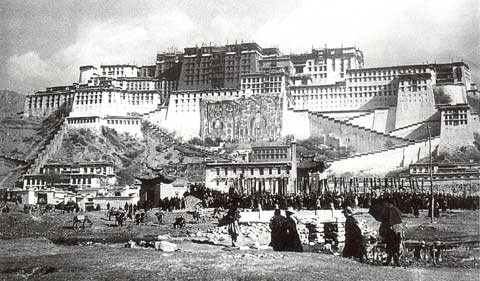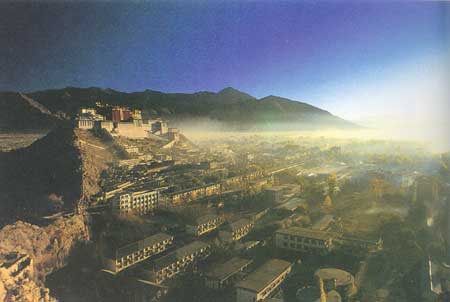Potala Palace
-
Construction time: 1645 - 1695 (with more additions later)
-
Location: Lhasa, Tibet
The Potala Palace is considered a symbol of Tibetan polity at a time when the nation was unified under the rule of Buddhist Dalai Lama, having performed that function at a level of admiration and creation. the image of Tibet's quintessential visual symbol for outsiders and this image is expressed in various groups in the claim of control over Tibet . At the same time, the palace also helps us associate the Indian origin of Tibetan Buddhism, in fact backed by Mongolia to make construction possible, and decorate Chinese architecture. .

Photograph by Hugh Richardson, the representative of the British government in Tibet, was taken in the 1940s.
A Buddha-shaped banner flag floated over the building during a festival.
Named after a mysterious palace in South India by the Tibetan patron Buddha, Avalokiteshvara, the Potala palace was built on a site believed to be a small palace of the Tibetan founder in the 7th century, King Songtsen Gampo, who thought of the Potala construction project, the Fifth Dalai Lama (circa 1642-1682) was referred to as an incarnation of Avalokiteshvara. So the continuity and revival of the Tibetan state after the periods of separation were intentionally reaffirmed.
The Potala Palace runs along the top of a low mountain range overlooking the southern city of Lhasa, which is also part of a rectangular-shaped plot of land located at the foot of the mountain. The central part of the land has two main components: the White Palace in the East and the Red Palace in the West.
After being inaugurated by Gushri Khan - the Mongol king for His Holiness the 5th Dalai Lama as Tibetan ruler in 1642, the 5th Dalai Lama built White Palace from 1645 to 1648 and chose This place is my official residence. His final regent, Sangye Gyasho, built the Red Palace from 1690 to 1694 to unite the tomb of His Holiness the Dalai Lama.

Despite Lhasa's development in recent decades,
along with the rapid development of modern style buildings,
Potala palace is still outstanding in the city landscape.
Both Bach and Hong Cung eventually developed the design of ancient Indian monasteries . The meeting room on the first floor of the rectangle is surrounded by rooms that look inside, above the overlap from two or more floors with other small rooms, containing a strip of land created by the inner steps, open-air, onion lang above the big room. The inner spaces are mostly chapels, monasteries, living apartments of the Dalai Lama or their remains.
The Dalai Lama's tomb, 13 ( around 1895 - 1933 ), created Western-style development to the Hong palace built between 1934 and 1936. Peripheral buildings such as living quarters in The monastery at the western end, the science and the outside fortifications seem to be back to the 17th century, though many insignificant additions have been carried out over the years. The entrance through the narrow gate, which can be defended after stepping through much, has a staircase with a slope that is comfortable for cargo horses.
Despite a number of short-term encirclement, and the risk of frequent earthquakes and fires, damage due to the Cultural Revolution, the Potala palace has never been severely devastated and generally well-maintained. reasonable cultivation.
Construction
Diagram of the Potala palace

1. Central tower
2. Corner tower
3. Project the bottom of the southern corner
4. Works for thangkas
5. Residence of female monks
6. West round tower
7. The remains of the 13th Dalai Lama.
8. The outside of Hong Cung
9. Lobby of the Red Palace
10. Hong Cung
11. Chapel
12. Stronghold on the northern road
13. Works on the northern pillar 14. Amos of the 5th Dalai Lama
15. The remains of the 7th Dalai Lama
16. The remains of the 8th Dalai Lama
17. The remains of the 9th Dalai Lama
18. White bows
19. The outer court of the White House
20. School of religious dignitaries
21. Southern citadel
22. The ramp leads to the south entrance
23. The ramp leads to the western entrance
24. Western fortress
25. Round tower.
The top of the hill seems to be leveled into a strip of land by cutting and filling, a standard Tibetan technique, the outer wall of the building descends below the plain strip in many different elevations to create a sense of mountain range. growing up. In technology and material usage, the Potala Palace is generally not much different from the house in the Tibetan countryside - not surprisingly, the number of giants can only be recruited from local farmers.
Structural engineering is one of the massive bulkhead walls - in the case of rough slaked stone - to place solid wooden ceiling beams, this turn of wood beams is made into bearings for the beams. wood supports weightlifting floors on the wall. The inside of the girder is supported by wooden columns through long support. So the building on the outside gave way to the majority of wood inside. An unimportant difference with the rural housing structure is in small defensive towers at the east and west ends, with curved walls rather than straight walls. Most of the rock is transported from the upstream areas of Northeastern Lhasa, by porters and basket boats, while the majority of mud is dug right below the site, leaving many holes later renovated into decorative lakes. .

The White Palace façade is typical of Tibetan religious architecture, the slope of the wall is directed towards the interior,
Vivid color contrast and focus on decoration towards the top part.
The inner and outer wall coverings are constructed of horizontal layers of rock, usually about 25cm deep, and 30-50cm long, separated by thin layers of many small, slightly flatter rocks, compacted with mud to form a lining. flat to build layers of stone on top. In the lower walls and fortifications, the main stone wall has a very rugged shape and the insertion layers account for a larger proportion than the total number of classes. In places where the main layers of rock are completely surrounded by layers of inserts, this technique is called a "descriptive lining".
Typical in Tibetan architecture is the inner slope or the 6-9 degree slope of the outer wall from vertical , usually slightly larger in the lower section of the rougher construction. This necessarily creates a tilt of the layers that are carefully inserted towards the corners. Between the inner and outer shells, walls up to 5m thick are filled with soil, rock and willow branches crossed together. For the use of copper melting in the foot of the nail may be just a convention in literature.

Metal roofs in Chinese style support the roof-shaped touches of Indian origin.
Structural awnings cover cool doors and windows and decorative walls.
The sloping edge of the wall facing inside looks outwardly balanced by the columns of the wooden frame window, much like being closed at the lowest floor and sometimes widening to balconies on the upper floors. Their cylinders are sealed with protruding floor supports and mud roofs. The flat roof associated with the retaining wall, rather than plastering, in the outer surface is a collection of a lot of willow willows and shrubs, the ends of the ends are painted red. This is a fossilized version of a lot of fuels or hay still piled up around the Tibetan countryside roof.Wall decorated with lime paint or red ocher, often refreshed by pouring water from the top down . The rugged texture of the outer surface in adjacent houses increases the sense of homeland, the simplicity of the project.
Interior wood texture and wall surfaces are all heavy with carved and painted decorations. The most important point in the complex is marked at the highest elevation by the small gold-plated roofs of Chinese craftsmen and Indian-origin gold decorations of Nepalese craftsmen. a difference from the rural house style.
Actual data:
-
Number of floors: 13
-
Height: 117m
-
Materials: stone, wood, mud
-
Elevation: 3,700m
- Admire the 10 most magnificent palaces in the world
- Discover the world's largest gold-plated palace of the king of Brunei
- The color of Buddhism is impressive throughout Asia
- Explore the magnificent Royal Palace of Japan
- The Crystal Palace - The Crystal Palace
- Uncover the mystery of childbirth in the old palace ban
- Ruins of Qin Shihuang Palace surfaced on the beach
- Find the palace of Ode in the epic of the Morning
- Discovering vestiges of the palace during the Le So period in Thang Long Citadel
- Where is the bow in the Forbidden City?
- The 3000-year-old palace suspects King Solomon
- Found the palace in the tomb of Qin Shihuang
 Norway built the world's tallest wooden tower
Norway built the world's tallest wooden tower Kremlin
Kremlin Ashurbanipal: The oldest royal library in the world
Ashurbanipal: The oldest royal library in the world Decoding the thousand-year construction of Qin Shihuang shocked the world
Decoding the thousand-year construction of Qin Shihuang shocked the world